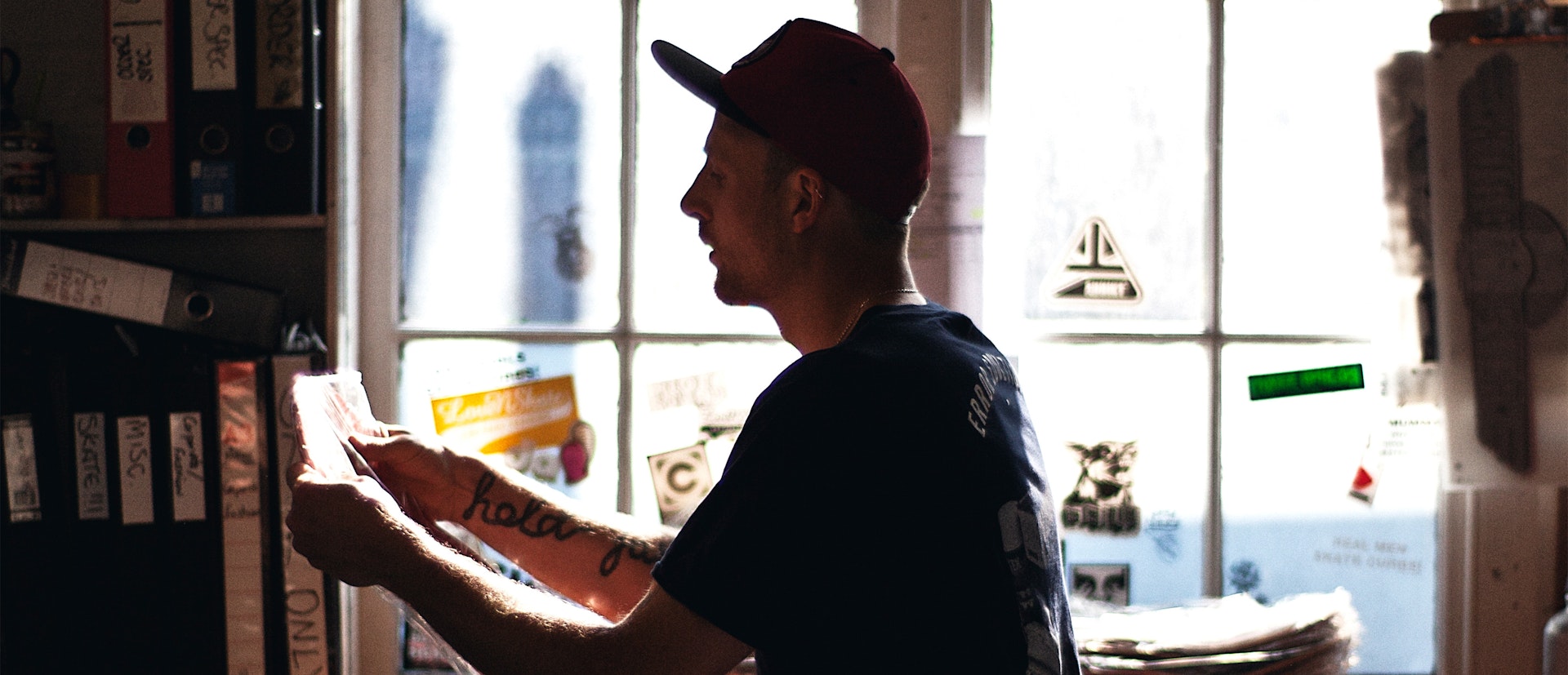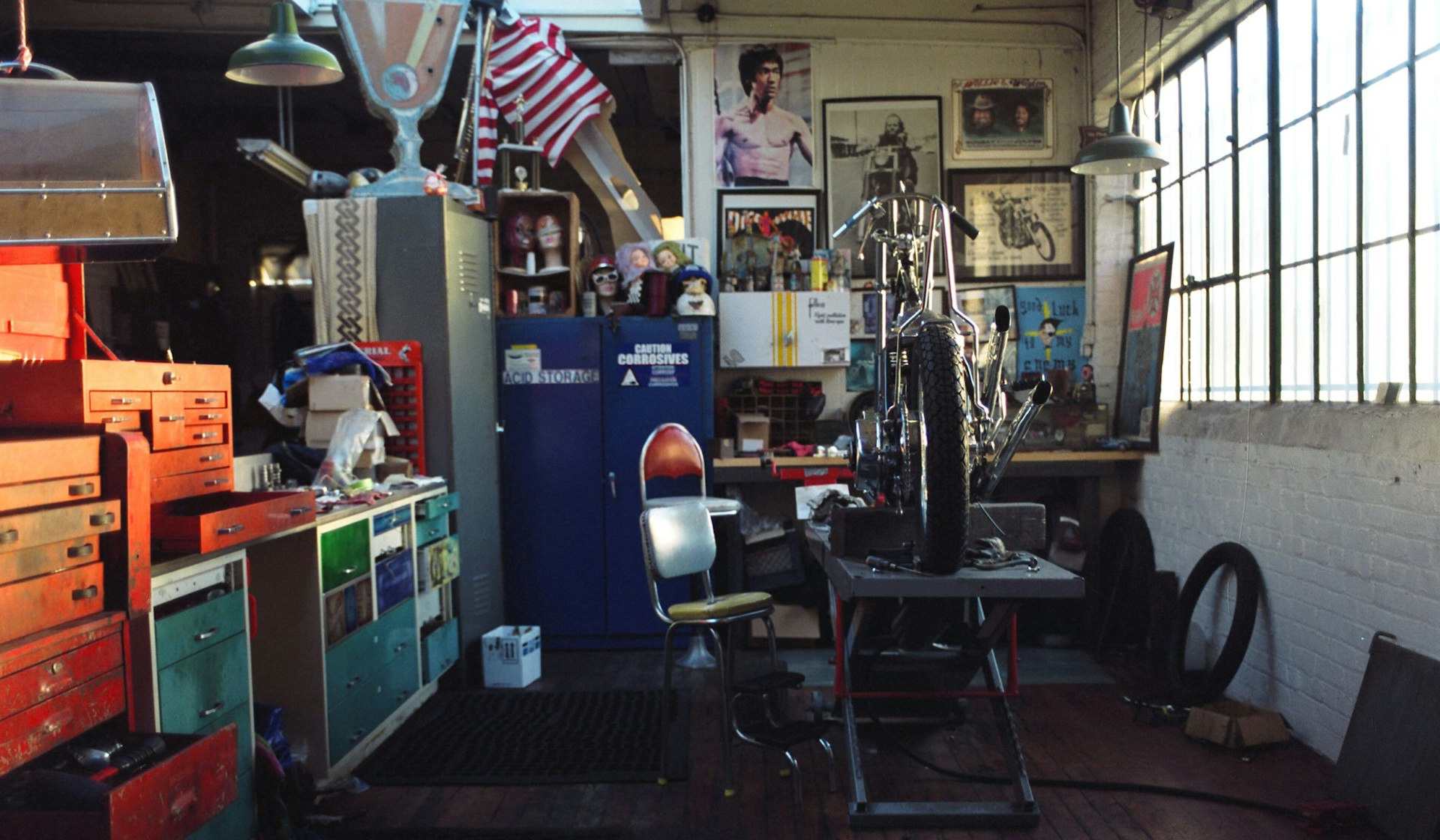
Lovenskate
- Text by Shelley Jones
- Photography by Adrian Morris
Stu Smith, founder of East London-based Lovenskate – a screenprint workshop and indie skate company – is a one-man force of positivity. He’s ripping around the bowl at the Victoria Park skatepark on a sunny June afternoon with artist and Lovenskate collaborator Paul Parker and the paint-flecked pinball is totally stoked.
That vibe – something Stu likes to call “a continuous process of bowl-shralping, street-ripping, wanderlusting, ink-blending, curb-waxing, gnar-shredding, DIY-or-die-ing, scene-supporting, quality-product-guaranteeing, slappy-nose-sliding, stair-jumping, team-building, ‘zine-living, loving and skating” – goes straight into every deck, tee, mug, sticker and ‘zine that Lovenskate print. Because, for Stu, skateboarding is the ultimate inspiration.
“Young kids that have mad amounts of energy for the physical act of skateboarding, that kinda keeps you charged,” Stu says over a pizza near Lovenskate’s studio on The Mangle – an old cobbled street of artists’ studios in a low-key part of Bethnal Green. “And then there’s the older group I grew up with – I love ‘80s and ‘90s skateboarding, too. There’s unlimited stimulus in skateboarding. It’s this creative release, I guess. And that’s easily transferred into photography or art or printing or whatever.”
Lovenskate – named, originally, as a play on the love/hate knuckle tattoos and inked for posterity across Stu’s toes – started as a ‘zine of photos from a Thrasher-inspired skate trip Stu took to South America in 2001. After getting back to the UK, Stu bought an old flatbed printer from a nearby factory and set it up in his parents’ garage in Kent. There he printed ‘zine covers and stickers and took on some freelance clients when he wasn’t working at South London print studio Bilko.
“It was always in the back of my mind that I wanted to learn how to print boards,” says Stu. “I watched that 411 video about the Screaming Squeegees, a screen-printing factory run by this amazing guy called Chicken, and they printed so much cool shit, everything from Jim Phillips, 101 and Blind to World Industries, Alien Workshop and Underworld Element. That really lit the fire.”
In 2006 Stu moved into the current Lovenskate crib, above much-loved illustrator and intricate die-cut artist Rob Ryan, and decided to print his first decks. But the technique proved to be something of a dark art. “It’s really shrouded in secrecy,” laughs Stu. “It’s all smoke and mirrors! The screens [for printing boards] have to be a certain tension and the shape of the mesh is actually completely different to the shape of the board. You have to over-exaggerate all these different angles. It’s taken me seven years to work out the perfect screen. I spent a lot of money on screen builders, but it was never right. Eventually I just made it myself.”
“It’s satisfying to know you made all that with your hands. You sweated, you threw your toys out of the pram a couple of times because it wasn’t going right, and suddenly it’s all there.”
Stu finally got the process down and went from printing twenty units at a time to runs of 100. With bright, sharp-edged graphics that range from storms in teacups and ghouls in pools to photocopied and collaged British gents and pop art-style red-hot chillies, Lovenskate has a distinct aesthetic. But it’s process, not ideology, that drives his design.
“If you’re limited in the machinery you can work with, then that ultimately limits your capabilities in design,” says Stu. “I might want to print some dude’s face and colour it like a rainbow, but I’m limited to the screen-printing possibilities. You may have to use block colours as opposed to intricate blends, for example. Or if they are blends then they’re blended on the silkscreen so each one is slightly different. It’s good to explore the medium you work with.”
With Lovenskate merch popping up in skate shops all over the country, Stu’s busier than ever. But the team – which now includes rad printers Lilli Cowley-Wood and Dave Rowswell – take on the lion’s share of commercial screenprint work under the ‘Error Solutions’ moniker, so Stu can dedicate himself to Lovenskate almost full-time.
“I’d go totally crazy if I wasn’t hands-on,” he says. “Half a day in front of the computer and I’m a horrible nightmare. I’m at my happiest when I know I’ve got a big pile of blank decks to print in a certain amount of time.”
He goes on: “Part of me enjoys being a robot – you just get in the zone. I guess it’s a challenge thing: can you produce these things to the best quality, in the way you envisioned it, in a certain amount of time? Go! It’s satisfying to know you made all that with your hands. You sweated, you threw your toys out of the pram a couple of times because it wasn’t going right, and suddenly it’s all there. And you can be content with knowing you actually lifted a finger to make something.”
The economy may not always be friendly to indie businesses, but Stu keeps Lovenskate humble and small so it never loses money. He supports a core team – “just my mates” – puts out videos and even launched a Lovenskate blend of tea this year. “Each time we’ve done a new series of boards we’ve kind of upped the ante a little,” says Stu. “So, what was a two-colour graphic, just in the centre of the board about two years ago, has now become a twelve-colour tip-to-tail. And that’s motivational in itself.
Lovenskate is constantly moving forward, but Stu’s determined to keep things local and not follow in the footsteps of transnational skate corps. “People don’t consider that it’s possible to produce stuff in the UK,” he says. “I mean that’s partly hypocritical because our boards are made abroad but that’s certainly not through a lack of trying to get a British manufacturer, it just hasn’t worked out yet. But I’m hoping that will change with this resurgence in craft and the hands-on approach. Back in the ‘90s, it was all about these multi-coloured vector graphics and very involved drawings but now everyone’s going for a handcrafted look. Craft shouldn’t be a luxury, it should be the norm. That’s the dream.”
As a company that does pretty much all their printing by hand using old-school techniques that involve cutting Amberlith or Rubylith for colour separations, Lovenskate don’t exactly make life easy for themselves. But Stu doesn’t think that limitations are a bad thing – “It makes you more considerate with what it is you’re trying to do,” he says – and, ultimately, he understands that the best things in life take a bit of hard graft.
“Skateboarding is, for me, all about energy,” says Stu. “Open a magazine and there are photos of energy, like tricks being done. But it all starts with a tree, which takes energy to grow. The wood goes to a factory, the plys are cut, they’re laminated together, then that deck gets decorated. In my case, the screens are made, the artwork’s hand-cut, it takes time. All that energy is then contained in a skateboard. Some kid comes along, stoked on skateboarding, buys that board, and then that energy explodes into the skatepark or the street, until it’s destroyed and the energy is dispelled elsewhere.”
He pauses and smiles: “I absolutely love that idea. And I don’t think it’s right that you should mute or dumb down any part of that energy or process. It’s just not skateboarding to do that.”
Check out more of Stu’s rad creations at Lovenskate and watch Huck’s video from his East London studio.
This article originally appeared in Huck 39 – The Sofia Coppola issue.
The Working Artisan’s Club, is presented by Huck and O’Neill to celebrate the rad makers who shape their future with their own two hands.
Stay locked for The Working Artisans’ Club 2014, coming soon.
